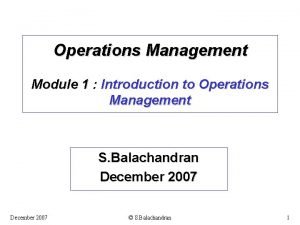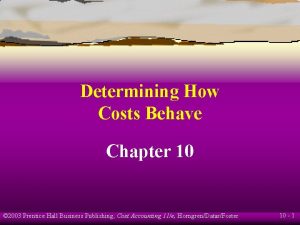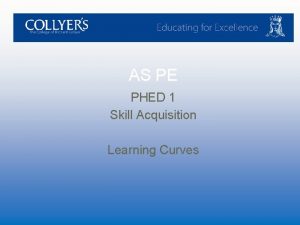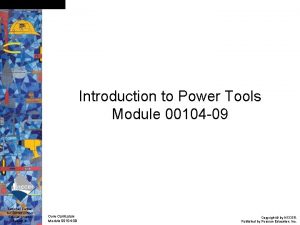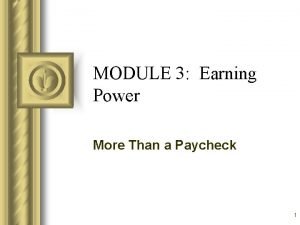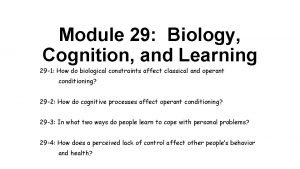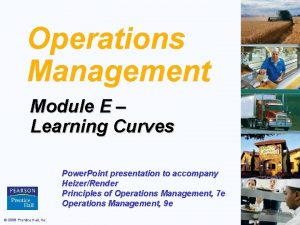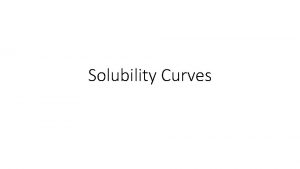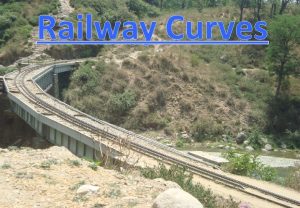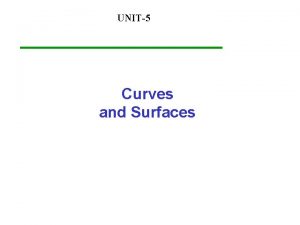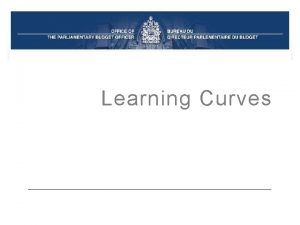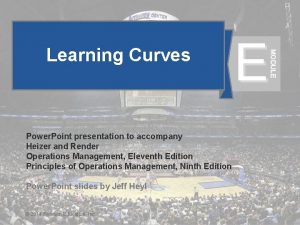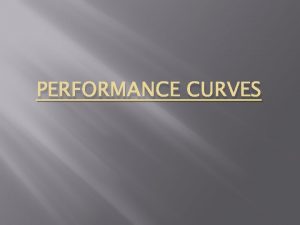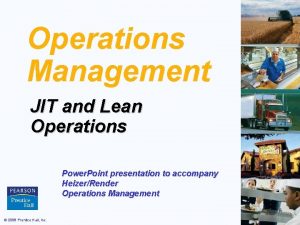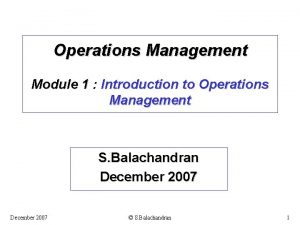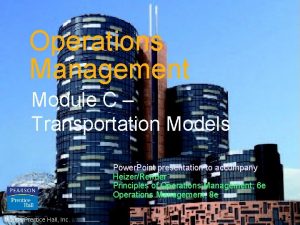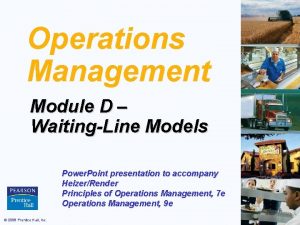Operations Management Module E Learning Curves Power Point





















- Slides: 21

Operations Management Module E – Learning Curves Power. Point presentation to accompany Heizer/Render Principles of Operations Management, 7 e Operations Management, 9 e © 2008 Prentice Hall, Inc. E–

Outline þ Learning Curves in Services and Manufacturing þ Applying the Learning Curve þ Arithmetic Approach þ Logarithmic Approach þ Learning-Curve Coefficient Approach þ Strategic Implications of Learning Curves þ Limitations of Learning Curves © 2008 Prentice Hall, Inc. E– 2

Learning Objectives When you complete this module you should be able to: 1. 2. Define a learning curve Use the arithmetic concept to estimate times 3. Compute learning curve effects with the logarithmic and learningcurve coefficient approaches 4. Describe the strategic implications of learning curves © 2008 Prentice Hall, Inc. E– 3

Learning Curves þ Based on the premise that people and organizations become better at their tasks as the tasks are repeated þ Time to produce a unit decreases as more units are produced þ Learning curves typically follow a negative exponential distribution þ The rate of improvement decreases over time © 2008 Prentice Hall, Inc. E– 4

Cost/time per repetition Learning Curve Effect 0 Number of repetitions (volume) Figure E. 1 © 2008 Prentice Hall, Inc. E– 5

Learning Curves T x Ln = Time required for the nth unit where T = unit cost or unit time of the first unit L = learning curve rate n = number of times T is doubled First unit takes 10 labor-hours 70% learning curve is present Fourth unit will require doubling twice — 1 to 2 to 4 Hours required for unit 4 = 10 x (. 7)2 = 4. 9 hours © 2008 Prentice Hall, Inc. E– 6

Learning Curve Examples Example Model -T Ford production Aircraft assembly Equipment maintenance at GE Steel production Improving Parameters Price Direct labor-hours per unit Learning. Curve Cumulative Slope Parameter (%) Units produced 86 Units produced 80 Average time to Number of replace a group of replacements parts Production worker Units produced labor-hours per unit produced 76 79 Table E. 1 © 2008 Prentice Hall, Inc. E– 7

Learning Curve Examples Example Integrated circuits Handheld calculator Improving Parameters Average price per unit Average factory selling price Disk memory drives Heart transplants Learning. Curve Cumulative Slope Parameter (%) Units produced 72 Units produced 74 Average price per bit Number of bits 76 1 -year death rates Transplants completed 79 Table E. 1 © 2008 Prentice Hall, Inc. E– 8

Uses of Learning Curves Internal: labor forecasting, scheduling, establishing costs and budgets External: supply chain negotiations Strategic: evaluation of company and industry performance, including costs and pricing © 2008 Prentice Hall, Inc. E– 9

Arithmetic Approach þ þ Simplest approach Labor cost declines at a constant rate, the learning rate, as production doubles Nth Unit Produced Hours for Nth Unit 1 2 100. 0 80. 0 = (. 8 x 100) 4 64. 0 = (. 8 x 80) 8 16 © 2008 Prentice Hall, Inc. 51. 2 = (. 8 x 64) 41. 0 = (. 8 x 51. 2) E – 10

Logarithmic Approach Determine labor for any unit, TN , by T N = T 1 (N b ) where © 2008 Prentice Hall, Inc. TN= time for the Nth unit T 1 = hours to produce the first unit b = (log of the learning rate)/(log 2) = slope of the learning curve E – 11

Logarithmic Approach Determine labor for any unit, TN , by T N = T 1 (N b ) where Table E. 2 © 2008 Prentice Hall, Inc. Learning Rate (%) unit b TN= time for the T 1 = hours to produce 70 the first unit –. 515 b = (log of the learning rate)/(log 2) 75 curve –. 415 = slope of the learning 80 –. 322 Nth 85 –. 234 90 –. 152 E – 12

Logarithmic Example Learning rate = 80% First unit took 100 hours T N = T 1 (N b ) T 3 = (100 hours)(3 b) = (100)(3 log. 8/log 2) = (100)(3–. 322) = 70. 2 labor hours © 2008 Prentice Hall, Inc. E – 13

Coefficient Approach T N = T 1 C where © 2008 Prentice Hall, Inc. TN = number of labor-hours required to produce the Nth unit T 1 = number of labor-hours required to produce the first unit C = learning-curve coefficient found in Table E. 3 E – 14

Learning-Curve Coefficients Table E. 3 70% 85% Unit Number (N) Unit Time Total Time 1 1. 000 2 . 700 1. 700 . 850 1. 850 3 . 568 2. 268 . 773 2. 623 4 . 490 2. 758 . 723 3. 345 5 . 437 3. 195 . 686 4. 031 10 . 306 4. 932 . 583 7. 116 15 . 248 6. 274 . 530 9. 861 20 . 214 7. 407 . 495 12. 402 © 2008 Prentice Hall, Inc. E – 15

Coefficient Example First boat required 125, 000 hours Labor cost = $40/hour Learning factor = 85% T N = T 1 C T 4 = (125, 000 hours)(. 723) = 90, 375 hours for the 4 th boat 90, 375 hours x $40/hour = $3, 615, 000 T N = T 1 C T 4 = (125, 000 hours)(3. 345) = 418, 125 hours for all four boats © 2008 Prentice Hall, Inc. E – 16

Coefficient Example Third boat required 100, 000 hours Learning factor = 85% New estimate for the first boat 100, 000 = 129, 366 hours. 773 © 2008 Prentice Hall, Inc. E – 17

Strategic Implications To pursue a strategy of a steeper curve than the rest of the industry, a firm can: 1. Follow an aggressive pricing policy 2. Focus on continuing cost reduction and productivity improvement 3. Build on shared experience 4. Keep capacity ahead of demand © 2008 Prentice Hall, Inc. E – 18

Price per unit (log scale) Industry and Company Learning Curves Figure E. 2 © 2008 Prentice Hall, Inc. In du C st om ry pr pa ice ny co st (c ) Loss (b ) Gross profit margin (a ) Accumulated volume (log scale) E – 19

Limitations of Learning Curves þ Learning curves differ from company to company as well as industry to industry so estimates should be developed for each organization þ Learning curves are often based on time estimates which must be accurate and should be reevaluated when appropriate © 2008 Prentice Hall, Inc. E – 20

Limitations of Learning Curves þ Any changes in personnel, design, or procedure can be expected to alter the learning curve þ Learning curves do not always apply to indirect labor or material þ The culture of the workplace, resource availability, and changes in the process may alter the learning curve © 2008 Prentice Hall, Inc. E – 21
 Learning curve operations management
Learning curve operations management Why are most roadways crowned?
Why are most roadways crowned? Operations module
Operations module Learning curves 2003
Learning curves 2003 Learning curves in sport
Learning curves in sport Triangle of power
Triangle of power Powerbi in powerpoint
Powerbi in powerpoint Point point power
Point point power Cuadro comparativo e-learning y b-learning
Cuadro comparativo e-learning y b-learning C device module module 1
C device module module 1 Operations and quality management
Operations and quality management Operations management chapter 12 inventory management
Operations management chapter 12 inventory management What is tqm
What is tqm Module 4 introduction to power tools
Module 4 introduction to power tools 00104-15 introduction to power tools
00104-15 introduction to power tools The power of laughter module c
The power of laughter module c Module 3 earning power
Module 3 earning power Learning: module 26: magnetic forces and fields
Learning: module 26: magnetic forces and fields Icici e-learning matrix answers pdf
Icici e-learning matrix answers pdf Module 29 biology cognition and learning
Module 29 biology cognition and learning Learning: module 2: section 19_03-19_05
Learning: module 2: section 19_03-19_05 Facilitating learning module 2
Facilitating learning module 2


